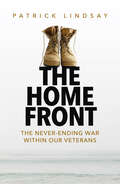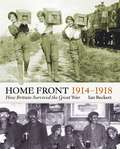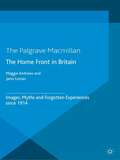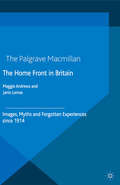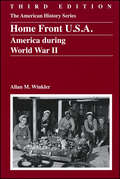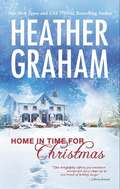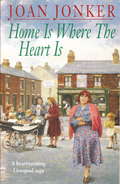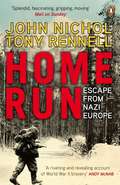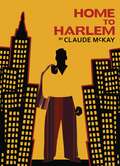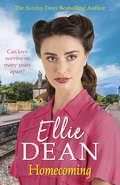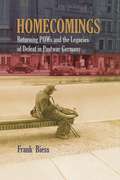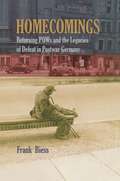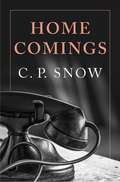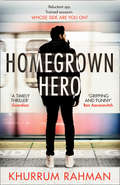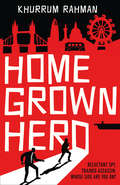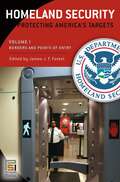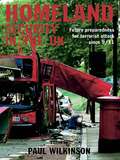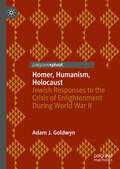- Table View
- List View
The Home Front: The never-ending war within our veterans
by Patrick LindsayForty-one Australian soldiers died in action over 20 years of fighting in Afghanistan; in that time more than 1400 veterans have taken their own lives. Veterans today are chronically over-represented when it comes to PTSD, depression, homelessness and suicide. Australians rightfully pause on Anzac Day each year to solemnly remember fallen soldiers, but are we forgetting our returned veterans whose personal battles continue every single day, and how did we get to this point?In this authoritative, compelling and urgent book, bestselling author Patrick Lindsay (The Spirit of the Digger and Fromelles among many) looks at the wide-ranging damage caused by training Australians to be fighting machines and then inadequately supporting them as they re-enter their communities. Featuring moving interviews with veterans and their families as well as a broader analysis of Australian military culture and government responses, Lindsay illustrates both the personal and societal costs of this dereliction of duty.The Home Front is a fascinating and rousing indictment of the culture of war, the thinking of those who wage it, and the cost to those who experience it.
The Home Front 1914-1918: How Britain Survived the Great War (Britain At War Ser.)
by Ian F.W. BeckettThe Great War had a profound impact on Britain. Not only did families risk their sons in active combat; every member of society was required to make a contribution to the war effort. National initiatives like rationing affected all, and civilians were now regarded as a legitimate military target. Reminders of this turbulent time survive today, in rituals such as Summer Time and Remembrance, nationwide war memorials, and the powerful myth of a lost generation slaughtered in a futile war. Here Ian Beckett examines the mobilization of the British people for the war effort and reassesses its impact on state and society. As evidence, he presents 40 key documents, including the King's rallying cry to the nation to 'eat less wheat', reports on social phenomena from anti-German riots to the drinking habits of women and juveniles, and Kitchener's initiatives to raise his New Armies.
Home front heroism: Civilians and conflict in Second World War London (Cultural History of Modern War)
by Ellena MatthewsHome front heroism investigates how civilians were recognised and celebrated as heroic during the Second World War. Through a focus on London, this book explores how heroism was manufactured as civilians adopted roles in production, protection and defence, through the use of uniforms and medals, and through the way that civilians were injured and killed.This book makes a novel contribution to the study of heroism by exploring the spatial, material, corporeal and ritualistic dimensions of heroic representations. By tracing the different ways that home front heroism was cultivated on a national, local and personal level, this study promotes new ways of thinking about the meaning and value of heroism during periods of conflict. It will appeal to anyone interested in the social and cultural history of Second World War as well as the sociology and psychology of heroism.
Home front heroism: Civilians and conflict in Second World War London (Cultural History of Modern War)
by Ellena MatthewsHome front heroism investigates how civilians were recognised and celebrated as heroic during the Second World War. Through a focus on London, this book explores how heroism was manufactured as civilians adopted roles in production, protection and defence, through the use of uniforms and medals, and through the way that civilians were injured and killed.This book makes a novel contribution to the study of heroism by exploring the spatial, material, corporeal and ritualistic dimensions of heroic representations. By tracing the different ways that home front heroism was cultivated on a national, local and personal level, this study promotes new ways of thinking about the meaning and value of heroism during periods of conflict. It will appeal to anyone interested in the social and cultural history of Second World War as well as the sociology and psychology of heroism.
The Home Front In Britain: Images, Myths And Forgotten Experiences Since 1914
by Maggie Andrews Janis LomasThe Home Front in Britain explores the British Home Front in the last 100 years since the outbreak of WW1. Case studies critically analyse the meaning and images of the British home and family in times war, challenging prevalent myths of how working and domestic life was shifted by national conflict.
The Home Front In Britain: Images, Myths And Forgotten Experiences Since 1914 (PDF)
by Maggie Andrews Janis LomasThe Home Front in Britain explores the British Home Front in the last 100 years since the outbreak of WW1. Case studies critically analyse the meaning and images of the British home and family in times war, challenging prevalent myths of how working and domestic life was shifted by national conflict.
The Home Front in Britain: Images, Myths and Forgotten Experiences since 1914
by Janis LomasThe Home Front in Britain explores the British Home Front in the last 100 years since the outbreak of WW1. Case studies critically analyse the meaning and images of the British home and family in times war, challenging prevalent myths of how working and domestic life was shifted by national conflict.
Home Front U.S.A.: America During World War II (The American History Series)
by Allan M. WinklerNew scholarship on World War II continues to broaden our understanding. With each passing year we know more about the triumphs and the tragedies of America’s involvement in the momentous conflict. Tapping into this greater awareness of the accomplishments of both soldiers and civilians and a better recognition of the consequences of decisions made, Allan Winkler presents the third edition of his highly popular series volume. Informed by the latest historical literature and featuring many new thoughtfully chosen photographs, the third edition of Home Front U.S.A. continues to ponder the question of "the good war," the moral implications of the use of the atomic bomb, the implications of expanding wartime roles for women, African Americans, American Jews, the imprisonment of Japanese Americans at the hands of the federal government, and the experiences of the many other people who, though relegated to the fringe of mainstream society, contributed in important ways to the nation's successful prosecution of its greatest challenge.
Home In Time For Christmas (Mira Ser.)
by Heather GrahamMelody Tarleton is driving home for Christmas when a man—clad in Revolutionary War–era costume—appears out of nowhere, right in the path of her car.
Home is Where the Heart Is: A touching saga of love, family and hope (Eileen Gillmoss series, Book 3)
by Joan JonkerWhen tragedy strikes, a young mother's friends and family ensure she is never alone... Joan Jonker's saga, Home is Where the Heart Is, brings to life a close-knit Liverpudlian community, in the final instalment of the Eileen Gillmoss series. Perfect for fans of Katie Flynn and Dilly Court.'Warm, witty... loved by her legions of fans' - Liverpool EchoWhen fun-loving, eighteen-stone Eileen Gillmoss announces that she's expecting a baby, her husband Bill thinks it's another one of her jokes. After all, it's twelve years since Edna, their youngest, was born. But when it sinks in that a baby really is on the way, Bill is over the moon and decides that the family should move out of their two-up, two-down house in Liverpool to one with more spacious accommodation. Eileen digs her heels in at first, reluctant to leave the house she loves and friends and neighbours so dear. But a scare early in Eileen's pregnancy strengthens Bill's resolve to provide a more comfortable home for his wife. Before Eileen knows what's hit her, she's installed in a smart home with posh new neighbours. Then tragedy strikes and Eileen must come to terms with a loss far greater than leaving behind her beloved neighbourhood. She tries to put on a brave face, but she can't fool the people who love her, who miss the smile on that round, chubby face and the laughter ringing through her house. They vow to make amends and fate steps in to lend a helping hand... What readers are saying about Home is Where the Heart Is: 'From the first page you are drawn into this wonderful woman's life and family as if you belong there. Joan Jonker creates a web of family crises and tragedies mixed with the never flagging spirit of Eileen Gilmoss to keep you hungry for more' 'As always with Joan it's a mix of hard, nitty, gritty life and fun thrown into the mix, never a dull moment with her books, tears of woe one minute and laughter the next'
Home Run: Escape from Nazi Europe
by John Nichol Tony RennellThroughout the Second World War, thousands found themselves cut off behind the lines in Nazi-occupied Europe — soldiers were left stranded on beaches after the chaotic evacuation of Dunkirk, airmen flying operations against the Germans were blasted out of the sky by flak and fighters. They were alone and on the run in enemy territory with just one goal — to get back to Britain and to safety. Some made solitary treks through hundreds of miles of enemy territory, others attempted precarious sea crossings in stolen boats. Many placed their lives in the hands of brave civilians who risked the wrath of a brutal regime if they dared to offer assistance. Life for the evaders hung in the balance and if they were to survive they had to rely on guile and sheer luck.John Nichol and Tony Rennell tell the dramatic story of the heroes who made it home . . . and those who did not.
Home to Harlem (Harlem Renaissance Series)
by Claude McKayVINTAGE CLASSICS' HARLEM RENAISSANCE SERIES Celebrating the finest works of the Harlem Renaissance, one of the most important Black arts movements in modern history.'Why did I want to mix mahself up in a white folk's war? It ain't ever was any of black folks' affair'When Jake Brown joins the army during the First World War, he is treated more like a slave than a soldier. After deserting his post to escape the racial violence he is facing, Jake travels back home to Harlem. But despite the distance, Jake cannot seem to escape the past and the explosive ways in which it can culminate. Written with brutal accuracy, Home to Harlem is an extraordinary work, and was the first American bestseller by a Black writer. 'One of the most gifted writers of the Harlem Renaissance' Washington Post
Home to Seaview Key (A Seaview Key Novel #2)
by Sherryl Woods#1 New York Times bestselling author Sherryl Woods reveals that the most delightful surprises may await right in your own backyard!
Homecoming (The Cliffehaven Series #18)
by Ellie Dean**************PRE-ORDER NOW:THE EIGHTEENTH CLIFFEHAVEN NOVEL BY SUNDAY TIMES BESTSELLING AUTHOR ELLIE DEANPeace has finally been declared in the Far East, but for those living at Beach View Boarding House, the news brings mixed emotions. Peggy Reilly is devastated that her husband Jim will not be coming home for Christmas. And Sarah and Jane, who have lived at Beach View throughout much of the conflict, dread what they will find when they go back to Singapore. Life in Cliffehaven is in a whirlwind of change as the men return from the war and Peggy’s evacuee chicks begin to spread their wings and start new lives in different corners of the world.Peggy and Jim have longed to be together after so many years apart, but war has left them profoundly changed. Can they rekindle the loving, close relationship they’d shared before?
Homecomings: Returning POWs and the Legacies of Defeat in Postwar Germany
by Frank BiessThis book focuses on one of the most visible and important consequences of total defeat in postwar Germany: the return to East and West Germany of the two million German soldiers and POWs who spent an extended period in Soviet captivity. These former prisoners made up a unique segment of German society. They were both soldiers in the war of racial annihilation on the Eastern front and then suffered extensive hardship and deprivation themselves as prisoners of war. The book examines the lingering consequences of the soldiers' return and explores returnees' own responses to a radically changed and divided homeland. Historian Frank Biess traces the origins of the postwar period to the last years of the war, when ordinary Germans began to face the prospect of impending defeat. He then demonstrates parallel East and West German efforts to overcome the German loss by transforming returning POWs into ideal post-totalitarian or antifascist citizens. By exploring returnees' troubled adjustment to the more private spheres of the workplace and the family, the book stresses the limitations of these East and West German attempts to move beyond the war. Based on a wide array of primary and secondary sources, Homecomings combines the political history of reconstruction with the social history of returnees and the cultural history of war memories and gender identities. It unearths important structural and functional similarities between German postwar societies, which remained infused with the aftereffects of unprecedented violence, loss, and mass death long after the war was over.
Homecomings: Returning POWs and the Legacies of Defeat in Postwar Germany
by Frank BiessThis book focuses on one of the most visible and important consequences of total defeat in postwar Germany: the return to East and West Germany of the two million German soldiers and POWs who spent an extended period in Soviet captivity. These former prisoners made up a unique segment of German society. They were both soldiers in the war of racial annihilation on the Eastern front and then suffered extensive hardship and deprivation themselves as prisoners of war. The book examines the lingering consequences of the soldiers' return and explores returnees' own responses to a radically changed and divided homeland. Historian Frank Biess traces the origins of the postwar period to the last years of the war, when ordinary Germans began to face the prospect of impending defeat. He then demonstrates parallel East and West German efforts to overcome the German loss by transforming returning POWs into ideal post-totalitarian or antifascist citizens. By exploring returnees' troubled adjustment to the more private spheres of the workplace and the family, the book stresses the limitations of these East and West German attempts to move beyond the war. Based on a wide array of primary and secondary sources, Homecomings combines the political history of reconstruction with the social history of returnees and the cultural history of war memories and gender identities. It unearths important structural and functional similarities between German postwar societies, which remained infused with the aftereffects of unprecedented violence, loss, and mass death long after the war was over.
Homecomings (Strangers and Brothers #7)
by C. P. SnowThe personal life of Lewis Eliot, the central figure and narrator of C. P. Snow’s Strangers and Brothers, takes centre stage in this moving account of his wartime years.The suicide of Lewis’s desperately vulnerable wife, Sheila, ends a marriage fraught with difficulty and pain and shakes his world to the foundations. As Britain enters the Second World War he is swept up into the civil service, and meets Margaret Davidson, a woman who may offer him emotional redemption – but who is already married.With its exceptionally sensitive and insightful exploration of the human condition, Homecomings demonstrates C. P. Snow’s masterly insight into character, whether in the home or along the corridors of power.A meticulous study of the public issues and private problems of post-war Britain, C. P. Snow’s Strangers and Brothers sequence is a towering achievement that stands alongside Anthony Powell’s A Dance to the Music of Time as one of the great romans-fleuves of the twentieth century.Praise for the Strangers and Brothers sequence“Together, the sequence presents a vivid portrait of British academic, political and public life. Snow was that rare thing, a scientist and novelist.” Jeffrey Archer, Guardian“Balzacian masterpieces of the age” Philip Hensher, Telegraph“Through [the Strangers and Brothers sequence] as in no other work in our time we have explored the inner life of the new classless class that is the 20th century Establishment” New York Times“A very considerable achievement … It brings into the novel themes and locales never seen before (except perhaps in Trollope).” Anthony Burgess
Homegrown Hero (Jay Qasim #2)
by Khurrum RahmanShortlisted for the Crimefest Last Laugh Award and the Crimefest eDunnit Award 2019 ‘As gripping and funny as his first thriller’ Ben Aaronovitch Reluctant spy. Trained assassin.WHOSE SIDE ARE YOU ON?
Homegrown Hero (Jay Qasim #2)
by Khurrum RahmanShortlisted for the Crimefest Last Laugh Award and the Crimefest eDunnit Award 2019 ‘As gripping and funny as his first thriller’ Ben Aaronovitch Reluctant spy. Trained assassin.WHOSE SIDE ARE YOU ON?
Homeland Security [3 volumes]: Protecting America's Targets [3 volumes] (Praeger Security International)
by James J. ForestAmerica is a target; the homeland is under threat. While Americans have been targets of terrorist attacks for quite some time, September 11, 2001, awoke the nation to the reality that we are vulnerable in our homes, our places of work and worship, and our means of public transportation. And yet, we must continue to function as best we can as the world's most vibrant economic and political community. The current threat environment requires greater engagement with the public, as the necessary eyes and ears of the nation's homeland security infrastructure. However, to be effective, the public must be equipped with the knowledge of where and why specific locations and activities may be a terrorist target, what is being done to protect those targets, and how they can help. This three-volume set answers that need.The chapters of each volume of Homeland Security revolve around a core of central questions. Are we safer today than we were pre-9/11? What steps have been taken in all these areas to protect ourselves? What are the threats we face, and what new threats have developed since 9/11? Are we staying one step ahead of those who wish to do us harm? In 2002, more than 400 million people, 122 million cars, 11 million trucks, 2.4 million freight cars, and 8 million containers entered the United States. Nearly 60,000 vessels entered the United States at its 301 ports of entry. Clearly the amount of activity this represents will require a long-term commitment to innovation, organizational learning, and public vigilance to complement an already overstretched network of government agencies and security professionals.
Homeland Security in the UK: Future Preparedness for Terrorist Attack Since 9/11 (Political Violence Ser. )
by Paul WilkinsonThis book is a detailed examination of whether domestic security measures are striking an appropriate balance between homeland security and civil liberties in the post-9/11 era. Professor Paul Wilkinson and the other contributors assess the nature of UK responses to terrorism by key public and private-sector bodies, highlighting how these organizations can prevent, pre-empt, counter and manage terrorist attacks by using a matrix of factors such as types of terrorist networks, tactics and targets. The volume also compares and contrasts the UK's response with cognate states elsewhere in the EU and with the USA. While improved intelligence has helped prevent a major Al Qaeda attack, the authors conclude that there is still a `major question mark' over whether the country is adequately resourced to deal with an emergency situation, particularly in major cities other than London. The book also confirms that while the UK faces a `real and serious' threat of terrorist attack by Al Qaeda, it is better prepared for an attack than other EU member states. Homeland Security in the UK will be essential reading for all students of terrorism studies, security studies and politics, as well as by professional practitioners and well-informed general readers.
Homeland Security in the UK: Future Preparedness for Terrorist Attack since 9/11 (Political Violence)
by Paul WilkinsonThis book is a detailed examination of whether domestic security measures are striking an appropriate balance between homeland security and civil liberties in the post-9/11 era. Professor Paul Wilkinson and the other contributors assess the nature of UK responses to terrorism by key public and private-sector bodies, highlighting how these organizations can prevent, pre-empt, counter and manage terrorist attacks by using a matrix of factors such as types of terrorist networks, tactics and targets. The volume also compares and contrasts the UK's response with cognate states elsewhere in the EU and with the USA. While improved intelligence has helped prevent a major Al Qaeda attack, the authors conclude that there is still a ‘major question mark’ over whether the country is adequately resourced to deal with an emergency situation, particularly in major cities other than London. The book also confirms that while the UK faces a ‘real and serious’ threat of terrorist attack by Al Qaeda, it is better prepared for an attack than other EU member states. Homeland Security in the UK will be essential reading for all students of terrorism studies, security studies and politics, as well as by professional practitioners and well-informed general readers.
Homeland Security in the UK: Future Preparedness for Terrorist Attack since 9/11 (Political Violence)
by Paul WilkinsonThis book is a detailed examination of whether domestic security measures are striking an appropriate balance between homeland security and civil liberties in the post-9/11 era. Professor Paul Wilkinson and the other contributors assess the nature of UK responses to terrorism by key public and private-sector bodies, highlighting how these organizations can prevent, pre-empt, counter and manage terrorist attacks by using a matrix of factors such as types of terrorist networks, tactics and targets. The volume also compares and contrasts the UK's response with cognate states elsewhere in the EU and with the USA. While improved intelligence has helped prevent a major Al Qaeda attack, the authors conclude that there is still a ‘major question mark’ over whether the country is adequately resourced to deal with an emergency situation, particularly in major cities other than London. The book also confirms that while the UK faces a ‘real and serious’ threat of terrorist attack by Al Qaeda, it is better prepared for an attack than other EU member states. Homeland Security in the UK will be essential reading for all students of terrorism studies, security studies and politics, as well as by professional practitioners and well-informed general readers.
Homeland Security In The UK: Future Preparedness For Terrorist Attack Since 9/11 (Political Violence Ser. )
by Paul WilkinsonThis book is a detailed examination of whether domestic security measures are striking an appropriate balance between homeland security and civil liberties in the post-9/11 era. Professor Paul Wilkinson and the other contributors assess the nature of UK responses to terrorism by key public and private-sector bodies, highlighting how these organizations can prevent, pre-empt, counter and manage terrorist attacks by using a matrix of factors such as types of terrorist networks, tactics and targets. The volume also compares and contrasts the UK's response with cognate states elsewhere in the EU and with the USA. While improved intelligence has helped prevent a major Al Qaeda attack, the authors conclude that there is still a `major question mark' over whether the country is adequately resourced to deal with an emergency situation, particularly in major cities other than London. The book also confirms that while the UK faces a `real and serious' threat of terrorist attack by Al Qaeda, it is better prepared for an attack than other EU member states. Homeland Security in the UK will be essential reading for all students of terrorism studies, security studies and politics, as well as by professional practitioners and well-informed general readers.
Homer, Humanism, Holocaust: Jewish Responses to the Crisis of Enlightenment During World War II
by Adam J. GoldwynThis book examines how Jewish intellectuals during and after the Second World War reinterpreted Homer’s epics, the Iliad and the Odyssey, in light of their own wartime experiences, drawing a parallel between the ancient Greek genocide of the Trojans and the Nazi genocide of the Jews. The wartime writings of Theodore Adorno, Hannah Arendt, Erich Auerbach, Rachel Bespaloff, Hermann Broch, Max Horkheimer, Primo Levi, and others were attempts both to understand the collapse of European civilization and the Enlightenment through critiques of their foundational texts and to imagine the place of the Homeric epics in a new post-War humanism. The book thus also explores the reception of these writers, analyzing how Jewish child-survivors like Geoffrey Hartman and Hélène Cixous and writers of the post-Holocaust generation like Daniel Mendelsohn continued to read the epics as narratives of grief, trauma, and woundedness into the twenty-first century..
